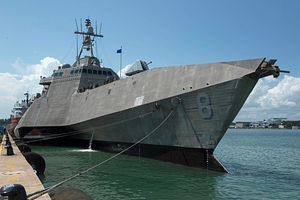The U.S. Navy has deployed its fourth littoral combat ship (LCS), the Independence-class USS Montgomery, to Singapore following a 19-month hiatus. The warship arrived at Singapore’s Changi Naval Base on 6 July, the service said in a recent statement.
“Rotational deployments by our littoral combat ships provide the presence and flexibility that are so important in this region,” said Rear Admiral Joey Tynch, the commander of Logistics Group Western Pacific, according to a U.S. Navy press release. “This platform is a utility player, ready to perform a full spectrum of tasking from maritime security operations and theater security cooperation to humanitarian assistance and disaster response. That versatility strengthens our ability to integrate with our partner navies in the Indo-Pacific.”
Previous LCSs that have been deployed to Singapore’s Changi and Sembawang naval bases are the Freedom-class USS Freedom, the Freedom-class USS Fort Worth, and the Independence-class USS Coronado. The Coronado deployed to the Indo Pacific region from September 2016 until November 2017 and was the first LCS to be fitted with an over-the-horizon anti-ship capability–the Advanced Harpoon Weapon Control System (AHWCS) capable of firing RGM-84D Harpoon Block 1C missiles.
Not a single LCS deployed in 2018.
“Like previous deployments of littoral combat ships, Montgomery will conduct operations, exercises and port visits throughout the region, as well as work alongside allied and partner navies to provide maritime security and stability, key pillars of a Free and Open Indo-Pacific,” according to the U.S. Navy. “Its unique capabilities allow it to work with a broad range of regional navies and visit ports larger ships cannot access.”
As my colleague Steve Stashwick pointed out back in 2017, past deployments of LCSs have seen their fair share of issues:
Three LCSs have deployed to Singapore since 2013, each experiencing major challenges. As the first LCS to deploy, the USS Freedom, had many “first in class” problems and maintenance issues, and the crew was found to be overworked and under-supported. The USS Fort Worth sustained a major casualty to its propulsion system that kept it out of action in Singapore for nearly six months before sufficient repairs were completed to allow it to return to the United States.
The USS Coronado suffered its own propulsion casualty while still en route to Singapore, forcing it to return to Hawaii for a month of repairs. Once in Singapore, major changes to the LCS crew concept and training pipeline to address some of the earlier high-profile problems meant that the follow-on crew was severely delayed, and crew that took the ship from the United States to Singapore ended up having to spend nine months on board instead of four or five.
Another LCS, the Independence-class USS Gabrielle Giffords, is also slated to deploy to the Indo-Pacific region later this year.

































